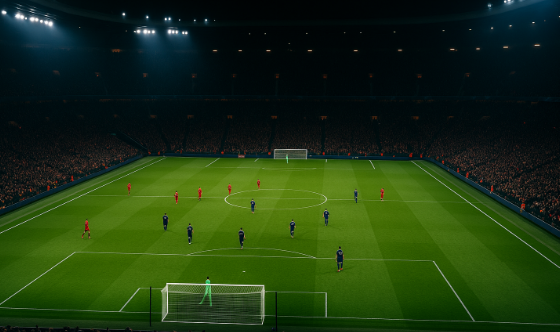
High Press Or Mid Block: Which Wins More Often?
October 7, 2025 8:04 am Leave your thoughtsEvery fan knows the feeling: your team flies out of the blocks, hunts in packs, wins the ball high, and suddenly the stadium hums. That’s the high press at its best—chaos that turns into chances. The mid-block tells a different story. Lines tuck in, passing lanes close, and the game becomes a funnel toward traps you’ve set. Both plans win matches. Both can also hand the initiative to the opponent if executed poorly.
The real question isn’t which is “better” in theory; it’s which wins more often with your squad, your opponent, your schedule, and your game state.
Here’s a practical way to think about the trade-offs so your next post-match debate is about choices, not clichés. And just as analytics are reshaping tactics in football, digital industries—even areas as far removed as streaming platforms or the best sex cam sites—remind us how data and execution, not labels, ultimately decide winners.
What actually decides your defensive height
The promise of the high press
A good press manufactures shots from bad opponent decisions. You’re not waiting for brilliance—you’re engineering turnovers near goal. The recipe is simple to describe and hard to deliver: tight distances between lines, clear triggers (back pass, heavy touch, weak foot receiving), and a back line brave enough to hold halfway while the keeper plays sweeper. Pressing also compresses the pitch, which shortens your own build-up and lets even average technicians play forward early. When it clicks, territory becomes a permanent advantage, and opponents stop trying to play.
Where the press loses you points
The risks are obvious. One lost duel, and the press is behind the ball. A single clean wall-pass or chipped diagonal, and your centre-backs are retreating toward a lot of empty grass. Refs in some leagues whistle aggressive contact quicker than others, so fouls add up and slow momentum. Fatigue matters too: the press that looked frightening in minute 20 can get ragged by minute 70, especially after a midweek away day. Without a ruthless “rest defense” behind the ball—full backs tucked, holding midfielder screening first passes—you’ll concede the exact chances you were trying to prevent.
What a mid block really aims to do
The mid block isn’t “parking the bus.” It’s control. You bait passes into predictable lanes, keep your distances pristine, and challenge opponents to break you without openings behind. The front players steer play to a side, the midfield screens forward passes, and the back line handles crosses on its terms.
Teams using a mid-block often win matches by ruling the middle third: they force rushed switches, pick up second balls, and counter from better structure. You trade raw volume of high regains for cleaner transitions and fewer five-alarm moments.
Where the mid block fails
Sit too passively and you donate territory. You also invite long-range shots and a constant stream of crosses. If your first line doesn’t angle the press, your midfield gets stretched horizontally and the block loses shape. Another problem: when you finally win the ball, you’re farther from goal. If your counter is slow or your nine can’t make it stick, you’ll spend long spells defending without the reward of sustained possession.
What the numbers usually tell us
Different leagues publish different metrics, but a few patterns hold. Teams that press well enough to force a high volume of miscues in the first two phases (goalkeeper build-up and first pass) tend to create higher-value chances than teams that win the ball in the middle third. That’s expected; turnovers near the box are gold. On the other hand, teams with only an average press but a very clean mid block often concede fewer big chances overall, because they avoid the catastrophic two-on-twos that break a game. In plain language: an elite press wins more when it’s truly elite; an average press loses to a tidy mid block. The break-even point is your ability to keep the back door shut while chasing the front door.
Game state changes everything
Press high when you’re losing; manage space when you’re winning. It sounds trite, but it’s the spine of match management. When chasing a goal, pressing raises shot volume quickly and turns throw-ins, goal kicks, and poor clearances into set-piece pressure. Protecting a lead favors the mid block because it limits the chaos that gifts opponents quick equalizers. Managers who switch heights cleanly—press on restarts, mid block in open play, late all-out squeeze in the final five—steal points without changing personnel.
The role of personnel
For a high press to thrive
You need a front three who understand angles, not just effort; a number eight who arrives on the blindside to close the trap; and centre-backs quick enough to win footraces in the channel. The goalkeeper must be comfortable patrolling 30–40 meters from goal and hitting clipped passes to relieve pressure. Full backs should recover speedily and defend the far post when the press is broken.
For a mid block to hum
Centre-backs must dominate the box and communicate across the line. The holding midfielder is your metronome, screening passes into the striker and orchestrating side-to-side shifts. Wingers do a lot of unnoticed work: they split the difference between full back and centre-mid, making sure switches arrive slow enough for the block to slide. Your nine either needs to be a target who starts counters or a runner who threatens depth so opponents can’t squeeze you indefinitely.
Hybrid plans that win seasons
The best teams don’t marry a scheme; they marry the game. They might press fully for 15 minutes to tilt the field and build a lead, then settle into a mid block that keeps distances tight and legs fresh. They’ll press goal kicks man-to-man, drop off on throws, and trigger a coordinated squeeze only on a back pass or a weak-foot reception. On defensive corners they’ll retain two fast outlets to threaten the counter and dissuade an opponent from overloading. None of this is random; it’s scripted on Tuesday and adjusted on Saturday.
Training patterns fans can spot
Watch the warm-ups and you’ll glimpse the week’s emphasis. If you see waves of three chasing into mannequins with a coach shouting “back, back, set,” expect a full squeeze with frequent resets. If the session is compact rondos with strict three-touch rules and lots of side-to-side shuffling, a mid block is coming. During the match, listen for the calls. A good press is loud. A good block is constant: short steps, small corrections, no lunges.
Set pieces and transition balance
Pressing teams earn corners and wide free kicks just by camping in the final third; that set-piece volume turns into goals over a season. Mid-block teams often trap for counters and win penalties or cut-backs because the opponent’s shape is broken when they lose the ball. Either way, the margins are in restart detail. If you’re debating which style “wins more,” check your club’s set-piece table; it frequently decides close races more than your pressing height does.
Fixture congestion and travel
Fatigue punishes pressing harder. A three-match week with long travel favors mid-block stretches and selective sprints. The clever version is “pressing in pockets”: you squeeze on restarts only, or for the five minutes after halftime, then manage the rest.
When your bench runs deep with like-for-like athletes, you can keep the press alive with rolling changes; otherwise you risk the late collapse that turns a dominant hour into a painful draw.
A fan’s checklist for the next matchday
Want to judge which approach is winning in real time? Try this quick scan.
- Are turnovers near the opponent’s box turning into shots within ten seconds? If yes, the press is paying off.
- Are you conceding clean diagonals behind your full back? If yes, your press lacks cover.
- Are opponents switching play slowly and settling for harmless crosses? The mid block has them right where you want them.
- Do your counters die at the halfway line? You may need one more runner or a nine who can hold the first pass.
- Are set pieces piling up in your favor? Territory from pressing or counters from trapping is doing its job.
What wins more for your club right now
If your squad has pace at centre-back, a proactive keeper, and forwards who read triggers, a high press will likely deliver more points over a season. If your strengths are aerial dominance, a screening six with radar for passing lanes, and wingers who work without the ball, the mid block will keep you in games and grind the table upward. Most clubs blend both: sprint to tilt the field, settle to protect it. The art isn’t picking a side; it’s picking moments. That’s where seasons are won—on choices repeated quietly for 90 minutes, week after week.
Categorised in: Championship Blog
This post was written by meg
